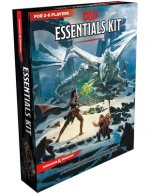
Kód: 07088090
Let me be your Teddy bear. Function and Development in John Osborne's "Look back in Anger" and "Déjà Vu"
Autor Konstantin Seitz
Seminar paper from the year 2007 in the subject English Language and Literature Studies - Literature, grade: 14 Punkte, University of Marburg (Institut für Anglistik/Amerikanistik), course: HS British Drama: From the 1950ies to th ... celý popis
- Jazyk:
 Angličtina
Angličtina - Väzba: Brožovaná
- Počet strán: 20
Nakladateľ: Grin Verlag, 2007
- Viac informácií o knihe

15.71 €
Bežne: 17.40 €
Ušetríte 1.68 €

Skladom u dodávateľa
Odosielame za 8 - 10 dní
Mohlo by sa vám tiež páčiť
-

Berserk Deluxe Volume 1
44.42 € -12 % -

Berserk Deluxe Volume 2
52.23 € -22 % -

Haunting Adeline
30.73 € -

Cry Baby Coloring Book
9.83 € -13 % -

Hunting Adeline
31.74 € -

Berserk Deluxe Volume 3
48.89 € -3 % -

The Official Stardew Valley Cookbook
23.32 € -19 % -

Powerless
11.96 € -7 % -

Atomic Habits
16.32 € -29 % -

White Nights
3.54 € -

Berserk Deluxe Volume 4
46.55 € -8 % -

Chainsaw Man, Vol. 15
10.44 € -19 % -

Gravity Falls Journal 3
18.35 € -13 % -

Harry Potter and the Prisoner of Azkaban (Minalima Edition)
35.09 € -14 % -

House of Leaves
23.22 € -22 % -

JUJUTSU KAISEN V22
10.34 € -23 % -

Iron Flame
16.22 € -25 % -

Dungeons & Dragons Essentials Kit (D&d Boxed Set)
30.12 € -

No Longer Human
13.48 € -16 % -

Surrounded by Idiots
10.74 € -10 % -

Berserk Deluxe Volume 5
50.51 €
Darčekový poukaz: Radosť zaručená
- Darujte poukaz v ľubovoľnej hodnote, a my sa postaráme o zvyšok.
- Poukaz sa vzťahuje na všetky produkty v našej ponuke.
- Elektronický poukaz si vytlačíte z e-mailu a môžete ho ihneď darovať.
- Platnosť poukazu je 12 mesiacov od dátumu vystavenia.
Viac informácií o knihe Let me be your Teddy bear. Function and Development in John Osborne's "Look back in Anger" and "Déjà Vu"
Nákupom získate 39 bodov
 Anotácia knihy
Anotácia knihy
Seminar paper from the year 2007 in the subject English Language and Literature Studies - Literature, grade: 14 Punkte, University of Marburg (Institut für Anglistik/Amerikanistik), course: HS British Drama: From the 1950ies to the present, 10 entries in the bibliography, language: English, abstract: In John Osborne's last play Déjŕ Vu (1991) the protagonist J.P., who appeared as young Jimmy in Look Back in Anger (1956) as the prototypical 'angry young man', seems to have changed. J.P. has a son and a daughter (who live with their mother, his third ex-wife), and 'enjoys' life in a 15-room-flat with his papers, pipe and his pal Cliff as a visitor every now and then. Having come to some wealth enables him to drink champagne, but he has nontheless not come to friendly terms with the world outside. As proposed by Peinert and various others, the animal imagery -i.e. the 'bear and squirrel' game- is a central key element to the understanding of Look Back in Anger as a whole and particularly with regard to the figures of Alison and Jimmy. How can this theory be applied to the figure of Teddy in Déjŕ Vu, where the tattered teddy bear seems to have risen from being a toy on a chest of drawers to a full member of the family with his own views and qualities. The aim of this paper is to have a close look at the figures of 'bear' and 'squirrel' in Look back in Anger and of 'Teddy' in Déjŕ Vu and to compare the 'bear' and 'Teddy'figures with regard to the following questions: How is the bear metaphor used in Look back in Anger and to what extent does it match Jimmy's being? What role does the teddy bear figure play in relation to the different protagonists in the two plays? And is there a development from bear to Teddy similar to the development from Jimmy to J.P. in the two plays?
 Parametre knihy
Parametre knihy
15.71 €
- Celý názov: Let me be your Teddy bear. Function and Development in John Osborne's "Look back in Anger" and "Déjà Vu"
- Autor: Konstantin Seitz
- Jazyk:
 Angličtina
Angličtina - Väzba: Brožovaná
- Počet strán: 20
- EAN: 9783638865395
- ISBN: 3638865398
- ID: 07088090
- Nakladateľ: Grin Verlag
- Hmotnosť: 44 g
- Rozmery: 210 × 148 × 2 mm
- Rok vydania: 2007
Osobný odber Bratislava a 2642 dalších
Copyright ©2008-24 najlacnejsie-knihy.sk Všetky práva vyhradenéSúkromieCookies


 21 miliónov titulov
21 miliónov titulov Vrátenie do mesiaca
Vrátenie do mesiaca 02/210 210 99 (8-15.30h)
02/210 210 99 (8-15.30h)